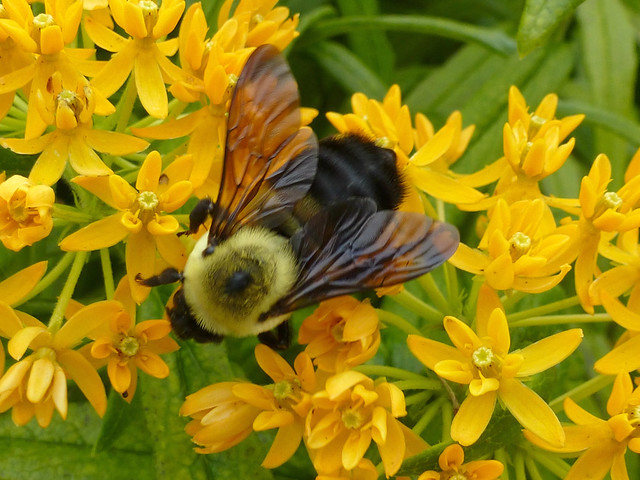The Plight of the Bees

BY MOIRA MOYNIHAN
During my semester abroad in France, our program sent us on a short sejour to a small town along the Spanish border named Céret. A century earlier, the likes of Pablo Picasso, Henri Matisse, and Salvador Dalí had been drawn there by the allure of southern France and the vast countryside sprawling along the foothills of the Pyrenees. At the dawn of each printemps, the landscape would change with the blossom of the cerisies, a sure marker of the upcoming harvest crucial to the town’s agricultural economy. But in the space of a century, this process has become more uncertain each year with the seemingly inexplicable loss of bee populations crucial to the process of the pollination and bloom of these plants.
My host mothers’ home sat immediately beside one of these cherry tree plots, and I was there just in time for the annual blossom. I spoke with the farmer who owned this and many other plots of land, and despite the beautiful backdrop of fields of trees in bloom, underlying our conversation was the harsh reality that M. Alexandre’s livelihood was dependent on cultivating crops that depended heavily on pollination, and that the drastic decline of bee populations affected him more and more each year.
This narrative is not unfamiliar. In the past months, Time has run a front cover story on the disappearance of bees; articles have appeared in The New York Times and stories have run on NPR; even Whole Foods adopted the cause, asking its consumers to “Bee the Solution.” Yet, despite all the media attention and scientific study, the loss of the world’s bee populations remains inexplicable. Experts are neither sure of the root of the problem nor how we should go about solving it. At present, scientists suspect that either parasites or pesticides bear the lion’s share of the blame.
The Varroa Mite’s dominance as a parasite is a byproduct of global agricultural mechanisms. Its introduction into non-native environments has proven fatal for countless bee colonies. Their presence can devastate a colony, and they serve as a catalyst for viruses that prove fatal to bees. The beekeepers in Céret with whom I spoke reported having to burn entire colonies upon discovering these mites, accepting the harsh reality that the loss of one colony carried significantly less negative impact than a Varroa Mite infestation.
In the past half a century, American bee populations have diminished between 40-50 percent according to a Yale study. Unsurprisingly, this fall in population is also acutely correlated with the agricultural world’s increased reliance on pesticides. While the early, extremely harsh pesticides used on plants have largely been phased out, a new class of pesticides, neonicotinoids, that were introduced in the 1990s have now become another suspect in the disappearance of bees. Though thought to be safer for bees than the harsh pesticides of decades past, another sudden drop in the bee population in 2004 has caused activists to point to these neonics as the culprits. However, the data surrounding this claim is contradictory and confounding, since, though the US bee population has substantially diminished, Australia, Canada, and Europe, where the pesticide is also widely used, have not experienced the same drastic losses. Moreover, the beekeepers that I spoke to in southwestern France neither used pesticides nor experienced Varroa infestations regularly, yet they too would return to find entire hives dead or vanished, further underscoring just how little we know about their disappearance.
The loss of bees would fundamentally alter the composition of our agricultural world (eliminating at least 1/3 of the foods we eat), according to the same Yale study. Moreover, because the cause of the loss of bees is still unknown, advocates struggle greatly to rally people behind the cause. Unfortunately our inability to understand the problem does not exclude us from its effects. In China, we see the results of inaction, as apple farmers now must pollinate their trees themselves by hand. Humans perform this work with enormous inefficiency compared to our bee counterparts, and it would be nearly impossible for the world to adopt this method and maintain its current levels of pollinated plant consumption.
The outlook for bees is not optimistic. At the end of my interview with one of the French beekeepers, it was clear that, to him, our chances of ameliorating the problem are slim. He assured me that, “they will disappear; man has no discipline,” a sentiment that has stuck with me as the plight of the bees moves more and more into the public eye. Man’s seeming inability to weigh the long-term consequences of our actions against the gratification these provide in the short term may ultimately be the downfall of this lynchpin insect. As we consume more meat, demand cheaper produce, and create longer shelf lives, the burdens on our agricultural system to produce greater quantities with more efficiency cannot be met without consequence.
Thus, our choices in the grocery store aisle matter enormously. Of course, these choices exist as a result of a certain amount of socioeconomic and educational privilege, so it is even more important that those who have these privileges take action. While we do not fully understand how we can quell the loss of crucial bee populations, our choosing to consume organic, sustainably grown products cannot hurt. The world must begin to make choices on behalf of bees, as it simply cannot afford not to.